

| Home | Log In | Register | Our Services | My Account | Contact | Help |
You are NOT currently logged in
dai oldenrich - 01 Sep 2006 13:32
click your browser refresh button to update charts
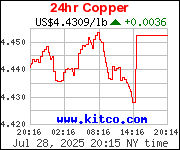
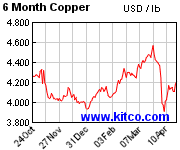
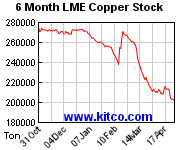
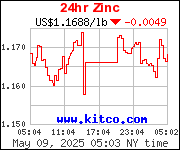
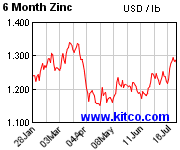
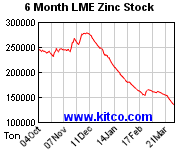
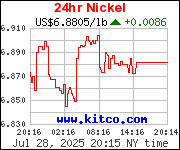
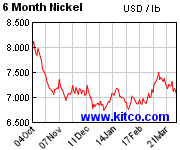
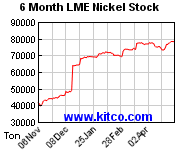
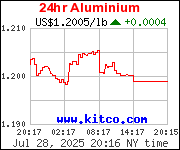
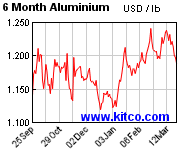
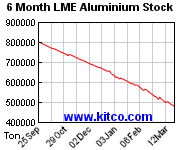
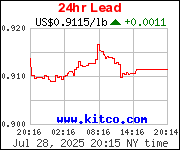
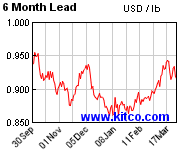
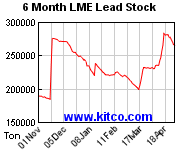
Also see: gold charts here silver charts here platinum charts here
dai oldenrich - 13 Oct 2006 07:24 - 108 of 181
Oct. 13 (Bloomberg)
Gold Declines in Asia After Traders' Charts Give Sell Signals - By Feiwen Rong
Spot gold in Asia fell, reversing some of yesterday's gains, after the charts that some traders use to predict price movements gave sell signals.
Gold for immediate delivery approached a so-called resistance level at $580 an ounce yesterday, marked by clusters of orders to sell the precious metal. The commodity had gained 1.1 percent to settle at $579.30 an ounce in New York as some investors' sought a hedge against rising inflation.
Bullion ``is not running on anything other than some resistance at that level,'' Ron Cameron, a resources analyst at Ord Minnett Ltd., said by phone from Sydney today. ``The market also gets a bit cautious before the weekend.''
Gold for immediate delivery fell as much as $1.20, or 0.2 percent, to $578.10 an ounce and traded at that level at 11:25 a.m. Singapore time. Still, the metal has gained 23 percent over the past year.
``$580 is a level which if we could trade through it, it could go for a reasonably strong rally,'' Cameron said.
Crude oil rose in New York after a report showed U.S. fuel demand increased for the first time in seven weeks and heating fuel supplies fell more than expected. Oil for November delivery rose as much as 52 cents, or 0.9 percent, to $58.38 a barrel in after-hours electronic trading on the New York Mercantile Exchange. It was at $58.26 at 11:36 a.m. in Singapore.
``Gold seems to have found some support at $570 level and it's unlikely to trade below it unless oil declines,'' said Chris Kwon, gold broker at Seoul-based HanMag Refco Futures Corp.
dai oldenrich - 13 Oct 2006 07:30 - 109 of 181
Friday, October 13, 2006 - Dow Jones Newswires
Range-Bound Gold Testing Investor Patience
Gold risks pullback if it continues to tread water, as selloff by some impatient investors "might kick off a nastier dip," warns Australia's CBA bank. Spot gold last at $578.70/oz, adding $2 to modest overnight gains in line with oil, EUR/USD, although remains at upper echelons of $560-580 range. "So far, gold has stayed out of trouble by avoiding the June lows" of around $540; "the proximity of those lows is a making us nervous because, should prices fall below that level, investor patience will be tested."
dai oldenrich - 14 Oct 2006 08:17 - 110 of 181
Oct. 13 (Bloomberg)
Gold Has Biggest Weekly Gain Since July as Crude Oil Climbs - By Choy Leng Yeong and Danielle Rossingh
Gold in New York had the biggest weekly gain since July as energy costs increased, boosting the appeal of the precious metal as a hedge against inflation.
The price of gold gained 2.8 percent in the past two days as crude-oil prices climbed 1.9 percent. The metal tumbled 4.5 percent last week and is down 19 percent from a 26-year high of $732 an ounce in mid-May. Oil climbed today on signs of growing U.S. energy demand and disruptions to supplies from Norway. Prices still have slumped 25 percent from $78.40 a barrel, the highest ever, in July.
``Gold is following oil tick for tick,'' said Michael Guido, director of hedge-fund marketing at Societe Generale in New York. ``You have technical funds buying gold.''
Gold futures for December delivery rose $12.40, or 2.1 percent, to $592.70 an ounce on the Comex division of the New York Mercantile Exchange, the biggest percentage gain since Sept. 5. The weekly gain was 2.8 percent. Prices are up 14 percent in 2006 and 25 percent from a year ago.
A futures contract is an obligation to buy or sell a commodity at a set price for delivery by a specific date.
Some investors buy gold to preserve purchasing power in times of accelerating inflation. Gold futures surged to $873 in 1980, when a jump in the cost of oil led to a 13 percent annual rise in U.S. consumer prices.
``The oil price is one of the reasons gold has spiked higher,'' said Frederic Panizzutti, a senior vice president at MKS Finance, one of Switzerland's four bullion refiners.
Gold may rally in coming days on investment demand, John Reade, an analyst at UBS AG in London, said in a report.
``We are hearing more positive signs from our wealth- management colleagues about private clients' intentions and activities in gold,'' he said.
Demand for StreetTracks Gold Trust, an exchange-traded fund that is linked to the price of gold, has risen 53 percent this year. The fund has 126.4 million shares outstanding, each representing a 10th of an ounce of gold.
dai oldenrich - 14 Oct 2006 08:17 - 111 of 181
Hoovers - 13 October 2006
LME metals end mostly higher, copper down
Bullish supply-side predictions for nickel, lead and tin saw all three metals end London Metal Exchange Week in fresh record-high territory while copper remained barely changed on the week, traders said.
Technical buying buoyed nickel, tin and lead to fresh highs amidst lackluster, rangebound trading in gold, oil and currency markets.
Fresh outflows of nickel from LME warehouses encouraged aggressive buying, lifting prices to record highs for the fifth consecutive session.
Nickel broke a new high at $31,150 a ton, up $650 on previous late kerb. Prices ended London's late kerb slightly lower at $30,750/ton, up $250 on previous PM kerb levels.
Aluminium, like nickel, was subject to "fairly agressive" buying pressure which was unchallenged by selling until prices hit $2,650/ton, a trader said. Aluminium ended Friday's session up $45 on previous PM kerb at $2,635/ton.
Supply-side concerns related to three smelter closures in Indonesia helped lift LME tin to a 17-year high of $9,950/ton, albeit on thin volumes, traders said. The smelters didn't have the correct operating permits, Indonesian police said.
Lead's upside momentum carried into a fifth session, lifting prices to a fresh cycle high of $1,512/ton, on the strength of system-driven momentum buying. Prices closed shy of highs at $1,490/ton, down $2 on previous kerb levels but up 5.5% on the week.
Unlike the remainder of the complex, LME copper "closed the week still somewhat hesitant," according to Triland Metals Ltd., down $20 on previous PM kerb and unchanged on the week at $7,460/ton.
dai oldenrich - 14 Oct 2006 08:19 - 112 of 181
FT.COM - October 12 2006
Structural shifts in copper market - By Chris Flood
New institutional funds flowing into the copper market have resulted in a historic shift in the relationship between prices and stocks, according to Bloomsbury Mineral Economics (BME), the metals consultancy.
The copper market has developed into a hybrid that is part industrial metals and part investment vehicle.
Investment demand has created a virtual deficit in the futures market, equivalent to 250,000 tonnes, which acts as a more powerful influence on prices than any slight rise in inventories.
However, BME stressed there was no speculative bubble in copper prices. This was shown by the narrowing in the spread between cash and three-month prices that purely speculative flows would have increased.
Instead, coppers price behaviour had been altered by remorseless pressure from investment buying, mainly via commodity index funds that hold about $105bn in futures, equivalent to about 600,000 tonnes of the red metal.
The recent growth in the popularity of structured notes has injected another $10bn into the market, with up to 300,000 tonnes being held as call options.
BME said there was now a triple deficit stretching across the copper market from concentrates to refined metals to the futures market.
The deficit in the copper concentrates market is expected to be the largest ever in 2006 at 330,000 tonnes, due partly to weak mine production.
Mine production has been lower than expected due to supply disruptions with strike action affecting output at La Caridad, Cananea and Escondida.
BME cut its estimate for mine production this year to 14.87m tonnes from 15.22m tonnes in April. This is well below the International Copper Study Groups current forecast of 15.17m tonnes for 2006, effectively the industry consensus.
For 2007 the situation is similar, with BME forecasting output of 15.86m tonnes, down from 16.16m tonnes in April and well below the ICSG forecast of 16.20m tonnes.
BME also said the refined copper market would remain in deficit this year at 300,000 tonnes and in 2007 at 100,000 tonnes with just a tiny surplus emerging in 2008.
Chinese consumption growth in 2006 has been revised up to 2.5 per cent instead of a decline of 4 per cent. West Europe consumption is expected to increase by 9.5 per cent compared with an earlier estimate of 7.5 per cent. The slowdown in the US housing market is expected to reduce consumption by 0.7 per cent this year, whereas a rise of 1.5 per cent was previously forecast.
Strategic stockpiles of refined copper are expected to be depleted by the end of 2007 with little opportunity for rebuilding before the next global recession.
Extremely high levels of exchange stocks will be required to drag prices back towards the $3,000 level, but even with increasing levels of stocks, prices are likely to remain much higher than previously.
dai oldenrich - 14 Oct 2006 08:19 - 113 of 181
The Independent - 14 October 2006
Are the good times over for commodities market? A super-cycle was predicted, so why are commodity prices off the boil, asks James Daley
What has happened to the so-called commodities super-cycle? Six months ago, commodity experts claimed the world had entered a 15- to 20-year bull market. By May this year, the gold price had more than doubled in five years, while the price of oil and copper had risen more than fourfold over the same period. From wheat to nickel to coffee, almost all commodities at least doubled in value over five years, to this spring.
The good times were supposed to continue. And yet, suddenly, commodity prices have come off the boil, as fears of a slowdown in the US economy have given investors the jitters. The Reuters/Jeffries CRB commodity price index is now down almost 20 per cent since May, despite continued demand from Asia, supposedly the underpinning for the super-cycle.
Ian Henderson, manager of JP Morgan's Natural Resources fund, says that the past few months have been a blip. "A lot of very fast money enhanced the commodities market in 2005," he says. "My view is that [short-term movements in prices] are the wrong thing to focus on - the focus should be on what's going on in China."
Although speculating investors have helped to boost commodity prices over the past 18 months, most fund managers and analysts agree that it is the rapid growth in developing countries such as China and India that is behind the recent bull-run.
Henderson points out that the International Monetary Fund has just increased China's growth forecast to 10 per cent for both this year and next year - almost four times the rate at which the UK economy is growing. "The super-cycle argument remains as true today as it was a year ago," says Graham Birch, who heads up Blackrock Investment Management's natural-resources team and manages the Merrill Lynch Gold & General fund.
"The drivers behind it are still the industrialisation and urbanisation of big developing economies, such as China and India. With these countries growing at 8 or 9 per cent a year, they're consuming more of the world's resources.
"We've seen weakness in the market recently because the US economy has slowed down a bit. But you don't expect markets to go in straight lines. This looks like a soft patch in what is a relatively strong market."
Mark Mathias, of Dawnay Day Quantum, which runs specialist commodity investments, is convinced that the recent fall in prices has created a fantastic buying opportunity, though he dismisses the notion of a super-cycle. "The super-cycle suggests we're in a bigger cycle than normal, but commodity cycles are all like this," he says. "The last commodities bear market lasted 20 years, so it's natural that the bull market might go on just as long."
Even so, for most investors, it's sensible to allocate just a small amount of your portfolio to the sector. Commodities are a good way to diversify, as they tend to have a low correlation with other asset classes. While stock markets plummeted in 2001-2, for example, commodities made strong annual gains.
Dan Kemp, head of fund research at Williams de Bro warns that investors shouldn't get carried away because of recent strong returns: "The enthusiasm we've seen for commodities has very little to do with diversification benefits, and everything to do with the fact their prices have been going through the roof."
Graham Tuckwell, chairman of ETF Securities, says that non-specialist investors should probably begin by allocating 3 to 5 per cent of their portfolio to commodities.
dai oldenrich - 14 Oct 2006 08:19 - 114 of 181
Oct. 13 (Bloomberg)
Copper May Fall on Speculation Chinese Use Is Slowing - By Chanyaporn Chanjaroen
Copper may drop next week on speculation demand for the metal in China, the world's largest user, will slow.
Chinese copper imports fell 24 percent in the first nine months of the year to 1.5 million metric tons, the country's customs office said yesterday. Ma Kai, China's top economic planner, said Oct. 9 that the nation will step up efforts to prevent the country's booming economy from overheating.
Six of 13 analysts, investors and traders surveyed by Bloomberg yesterday forecast copper will decline next week. Three expected a gain and four predicted little change.
Chinese demand ``continues to be on the slow side and I don't expect it to pick up for the balance of 2006,'' said Warren Gelman, president of St. Louis-based trading company Kataman Metals Inc. Copper will fall next week to about $3.30 to $3.40 a pound, or $7,275 to $7,496 a ton, he said.
Copper for delivery in three months on the LME rose $20, or 0.3 percent, to $7,500 a metric ton as of 11:57 a.m. local time. It has risen 0.1 percent this week.
On the Comex division of the New York Mercantile Exchange, copper for December delivery rose 1 percent to $3.42 a pound. Copper for December delivery on the Shanghai Futures Exchange gained 0.2 percent to close at 69,910 yuan ($8,848) a ton. Chinese prices include 17 percent tax and 2 percent duty.
China accounts for a fifth of global copper demand. Imports last month were 174,931 tons, the customs office said. Imports were 226,430 tons in September last year, according to data compiled by Bloomberg.
Lost Consumption
The country probably will consume about 3.8 million tons this year, a 5.6 percent increase from a year ago, according to Beijing Antaike Information Development Co., which advises the government on industry policies.
Copper has quadrupled in the last five years, and traded on the LME at a record $8,800 a ton on May 11. Some users have switched to cheaper materials, and the resultant lost consumption may rise to 400,000 tons this year, up 77 percent from last year, Peter Kettle, research director at U.K. industry consultant CRU, said in London on Oct.9.
The 225,000 tons lost last year from substitution was 1 percent of world demand and three times what was lost in 2004, Kettle said at a seminar organized by the London Metal Exchange. Stainless steel and plastics are benefiting the most, he said in an interview.
``Damage is being done to consumption and it's probably permanent,'' he said.
dai oldenrich - 15 Oct 2006 09:35 - 115 of 181
Associated Press - October 15, 2006
Drop in commodities may hurt emerging markets - By Ellen Simon
NEW YORK Commodities had a miserable third quarter and many on Wall Street say they have further to fall. That theory was bolstered last week as oil prices sunk to their lowest level for the year.
If commodities prices do sink further, it will be bad news for emerging markets and the investors who have poured billions of dollars into them over the past three years.
Commodities prices tend to have a domino effect lower oil prices often drag down gold prices, for instance. And lower commodities prices tend to push down stocks in emerging markets such as Russia and Brazil, countries with a rich supply of oil and metals, respectively.
While many emerging markets continue to be on a tear, if the commodity bears are right, there may be plenty of pain to spread around.
While investors pulled $263 million out of gold and natural resources funds for the week that ended Oct. 4, they still have $26.9 billion in the funds, according to Bank of America Corp. Fund flows into emerging markets slowed during the same period, but investors still have $96.6 billion riding on emerging market funds, according to Bank of America.
Stephen S. Roach, Morgan Stanley's chief economist, wrote in September that the tidal wave of money that has flowed into commodities over the last three years has transformed commodities markets "from one of the best real-time gauges of economic activity" to a financial asset like any other that is, one that's susceptible to hysteria and bubbles.
"Just as return-hungry investors chased these markets on the upside, they could well run like lemmings to get out on the downside," Roach wrote.
Merrill Lynch & Co.'s chief investment strategist, Richard Bernstein, agrees, saying that cheap money and heavy borrowing inflated prices in commodities. Those prices are now 60 percent above what could be explained by fundamental supply and demand, he wrote earlier this month.
"These data suggest that September's downfall in commodities might only be the beginning of a protracted bear market," he wrote.
Other factors that pushed commodity prices higher, such as the U.S. housing boom and powerful growth in the Chinese economy, also could drive prices lower. A slowdown in the housing market is well under way, and economists expect slower growth from China as well.
The decline in home construction already has hit the lumber market, where prices recently dropped to 5-year lows. Metals used in homebuilding, such as copper, also are facing price pressure.
Roach argues that a downturn for U.S. consumers could slow business for Chinese producers. U.S. consumers continue to gobble goods made in China, which is why the U.S. trade deficit with China was a record $22 billion in August. But if American consumers were to start cutting up their charge cards, the effects would be felt in Chinese factories almost immediately.
Less use in the U.S. auto industry should affect steel, aluminum, glass and rubber demand, wrote Tobias Levkovich, Citigroup Inc.'s chief U.S. strategist.
While the argument for continued high prices for commodities is that demand will continue to grow, Levkovich points out that there's some room for supply to grow, too, with a possible increase in Saudi oil production and a recent Chevron Corp. find in the Gulf of Mexico.
If the strategists are right, investors who have seen impressive run-ups in markets such as South Africa, where stocks are up more than 25 percent for the year to date, might consider taking some money off the table and away from all the other dominos.
dai oldenrich - 17 Oct 2006 07:55 - 116 of 181
The Times - October 17, 2006
Metal prices hit new highs - By David Robertson
LEAD, nickel and tin prices hit record highs at the London Metal Exchange yesterday, with all the key metals now achieving records in 2006.
Tin was the last of the metals to reach a record price this year when three-month delivery contracts reached $11,000 per tonne yesterday. This was up 12 per cent on the opening price and up 20 per cent over the past three trading sessions.
Traders blamed supply problems in Indonesia for the rise. Indonesian police have moved to shut down smelters operating in the country without permits.
The number of tin suppliers is relatively small compared with other metals, so small disruptions can cause exaggerated price movements.
Stephen Briggs, an analyst at SociGale, said: This has be to be delayed reaction to what is happening in Indonesia. Clearly, tin has been in the background for months, but this fundamental news has shot it into the limelight and investors are getting their teeth into it.
Lead also hit a new high yesterday, reaching $1,542 per tonne before falling back to $1,530 later in trading. Nickel prices rose to $31,300 per tonne.
Soaring demand from China and limited new discoveries of many key metals has forced prices up significantly during 2006.
Other metal prices also rose yesterday, with aluminium up 1.5 per cent to $2,675 and copper up 3.6 per cent to $7,730.
Zinc closed up 3.4 per cent at $3,930, just $40 short of its record high set on May 11.
dai oldenrich - 17 Oct 2006 22:18 - 117 of 181
FT.com - October 17 2006
Profit taking hits base metals - By Chris Flood
Zinc and nickel hit new records on Tuesday but profit taking later in the session dragged base metals lower after strong gains in recent days.
Zinc fell 2.4 per cent to $3,865 a tonne after it hit a record $4,020 a tonne earlier in the session. Physical availability is seen as extremely tight, encouraging interest from hedge funds and other momentum players.
Nickel rose to a record $32,050 a tonne but was unable to hold on to its gains and retreated 1.4 per cent to $31,400 a tonne. Global stocks remain critically low and sentiment is being supported by Eramets decision to declare force majeure (a form of legal protection) on nickel deliveries to Asian customers after disruptions to supplies to the worlds largest ferronickel plant in New Caledonia.
Tin fell 9.1 per cent to $10,000 a tonne after it hit a record $11,000 on Monday.
Disruptions to supplies in Indonesia and Bolivia (which account for about 35 per cent of global tin mine output) could push the market into deficit. The Indonesian government has closed more than 20 small smelters that were operating without proper permits.
The threat by Evo Morales, Bolivias president, to nationalise the countrys mining industry may not be as severe as it first appeared. Bolivias vice-president ruled out expropriations and the governments plans involve gaining control of new developments only. However, after tin gained 20 per cent in the previous three sessions, a pause was not unexpected and traders said consolidating above $9,800 would provide a new support level.
Lead fell 2.4 per cent to $1,497.5 after it hit a record $1,545 in the previous session.
Copper hit $7,872.5 a tonne but retreated 1.6 per cent to $7,640 in spite of news that the Gresik smelter in Indonesia will halt production until mid-December.
Crude prices were choppy as the market awaited clarification about plans to cut production by 1m barrels a day by the Organisation of the Petroleum Exporting Countries. The cartel is due to hold a meeting in Qatar later this week to finalise its plans.
ICE December Brent fell 86 cents to $60.80 a barrel while Nymex November West Texas Intermediate lost $1.09 at $58.85 a barrel.
Oil had rallied in morning trade in London, supported by an Opec statement on Monday which noted that uncertainties about global economic prospects, particularly in the USA, slowing demand growth, rebounding non-Opec supply and high stock levels have triggered a strong bearish sentiment in the market.
Edward Meir of Man Financial said This strong statement may have led the market to conclude that the cartel was looking beyond this weeks cut and possibly towards a second one, perhaps imposed in December.
The cartel will hold an emergency meeting later this week in Qatar but still it remains unclear if the cut will be made from the current quota level of 28m barrels a day or actual output running closer to 27.5m barels a day.
Wheat prices in Chicago hit a fresh 10-year high at $5.56 a bushel before retreating 4⅓ cents to $5.37 a bushel amid ongoing concerns about low levels of global stocks and the impact of drought in Australia on supplies.
Gold fell 0.8 per cent to $587.90 a troy ounce in spite of rising geopolitical tensions over North Koreas nuclear plans.
dai oldenrich - 17 Oct 2006 22:29 - 118 of 181
Oct. 17 (Bloomberg)
Tin Prices Plunge 10% on Sales by Producers; Zinc, Copper Drop - By Chanyaporn Chanjaroen
Tin in London plunged a record 10 percent as producers locked in sales to take advantage of prices at the highest in at least 17 years. Zinc fell after reaching the highest ever, and copper declined.
Lower tin production expected this year at PT Timah, the world's largest producer, and clashes among miners in Bolivia sent prices soaring 13 percent yesterday to the highest since 1989 yesterday. The countries account for about 35 percent of global production, UBS AG said today in report.
``Producers are selling forward their production as prices are at a very high level,'' said Charles Swindon, managing director of RJH Trading Ltd. in London. Funds are also selling to realize gains after prices rose yesterday, he said.
Tin for delivery in three months plunged $1,100, or 10 percent, to $9,900 a metric ton at 5:01 p.m. on the London Metal Exchange. A close at that price would mark the largest percentage decline ever. Prices yesterday reached $11,000, the highest since at least 1989.
Demand for tin, used mostly in soldering electronic components, will lag behind production by around 5,000 tons this year, London-based GFMS Metals Consulting Ltd said. Expanding use in China, the world's largest consumer of the metal, will help boost global consumption 7 percent to 390,000 tons in 2006, GFMS data showed.
Tin prices swing widely because trading volumes are the lowest among the six industrial metals traded on the LME, said Nick Moore, a London-based analyst at ABN Amro Holding NV. Supplies will remain ``tight,'' he said.
Supplies `a Concern'
PT Timah will cut output this year by 8 percent to 38,407 tons, Thobrani Alwi, the company's president director, said yesterday. Mines in Bolivia, which account for about 5 percent of world supply, were damaged after fatal clashes between miners, the newspaper El Diario reported last week.
``Supplies remain a concern,'' said RJH Trading's Swindon, who bought the metal today after prices fell.
Zinc for delivery in three months dropped $95, or 2.4 percent, to $3,865 a ton after reaching a record $4,020 earlier. Prices of the dark gray metal, mostly used to galvanize steel, have more than doubled in the past year.
Inventories tracked by the LME dropped 1,325 tons, or 1 percent, to 127,400 tons today. Stockpiles have declined for 15 months to the equivalent of less than five days of global consumption. Demand will exceed production by 420,000 tons this year, Societe Generale said last week in a report.
Copper
Copper prices declined $123, or 1.6 percent, to $7,645 a ton in London. On the Comex division of the New York Mercantile Exchange, futures for December delivery fell 9 cents, or 2.5 percent, to $3.491 a pound.
Freeport-McMoRan Copper & Gold Inc. said today third-quarter output dropped 11 percent from a year earlier. BHP Billiton Ltd. owns Escondida, the world's largest copper mine. Freeport's Grasberg mine in Indonesia is the second-largest.
Mitsubishi Materials Corp. suspended operations at its smelting unit in Indonesia until the middle of December. It will lose 52,000 tons of output. The unit can produce 250,000 tons a year.
dai oldenrich - 17 Oct 2006 22:30 - 119 of 181
Oct. 17 (Bloomberg)
Gold Futures Fall in New York After Oil Prices Erase Gains - By Pham-Duy Nguyen
Gold in New York fell for the first time in five sessions after a drop in oil prices reduced the metal's appeal as a hedge against inflation.
The price of gold has followed oil this year. The metal has fallen 19 percent from a 26-year high partly as oil shed 25 percent from a record in July. Oil today traded above $60 a barrel before erasing gains. Gold is still up 14 percent this year.
``If oil is going to let up, that's going to help bring down the price of gold,'' said Mike Sander, a commodity broker at Altavest Worldwide Trading Inc. in Mission Viejo, California.
Gold futures for December delivery fell $5 or 0.8 percent, to $593.50 an ounce on the Comex division of the New York Mercantile Exchange. Prices had gained 3.9 percent in the previous four sessions.
A futures contract is an obligation to buy or sell a commodity at a set price for delivery by a specific date.
Some investors buy gold when energy expenses climb. Gold futures reached a record $873 an ounce in January 1980 when oil costs doubled in a year, sparking a surge in the inflation rate.
Losses accelerated today after gold climbed above $600 and failed to make further gains, analysts said. Investors have placed orders to sell the metal around $600, said Marty McNeill, a gold trader at R.F. Lafferty Inc. in New York.
`Resistance' at $600
``Gold is backing off from $600,'' McNeill said. ``You have a lot of resistance at that level.''
Gold hasn't closed above $600 an ounce since Oct. 2.
``Gold came up to $600 and tested it but couldn't hold,'' Altavest's Sander said. ``That's a bearish sign for gold.''
Lower oil and gold prices are a buying opportunity, Marc Faber, founder and managing director of the investment firm Marc Faber Ltd. in Hong Kong, said at a conference in London.
``Gold and oil are in a buying range,'' said Faber, who told investors to bail out of U.S. stocks a week before the 1987 so-called Black Monday crash. ``I would buy gold at these levels. It's a good opportunity.''
Gold may also gain should tensions escalate with North Korea and investors buy the metal as a haven. South Korea said its northern neighbor may be preparing to test another nuclear bomb, after detonating one on Oct. 9.
``North Korea could become a big deal,'' said Frank McGhee, head metals trader at Integrated Borkerage Services Inc. in Chicago.
Silver for December delivery fell 13 cents, or 1.1 percent, to $11.78 an ounce. Palladium for December delivery dropped $4.95 or 1.5 percent, to $319.60 an ounce. Platinum for January delivery declined $8.30, or 0.8 percent, to $1,083 an ounce.
dai oldenrich - 18 Oct 2006 06:36 - 120 of 181
Oct. 18 (Bloomberg)
Copper in Shanghai Drops After U.S. Data Signals Slower Demand - By Xiaowei Li
Copper futures in Shanghai declined, paring yesterday's gain, after weaker-than-expected U.S. industrial production data signaled that demand for the metal used to make pipes and wires may fall.
The nation's industrial production fell 0.6 percent in September, the most in a year, the U.S. Federal Reserve said yesterday. The measure had been expected to fall 0.1 percent, according to the median estimate in a Bloomberg News survey of 61 economists. It was the first time in more than three years that production had fallen in consecutive months.
``The worse-than-expected US figures aside, we expected copper in Shanghai to correct downward from yesterday's highs,'' Li Xun, a trader at Shanghai Continent Futures Co., said today. ``We believe the falls so far are reasonable.''
Copper for December delivery dropped as much as 990 yuan, or 1.4 percent, to 71,280 yuan ($9,015) a metric ton on the Shanghai Futures Exchange.
dai oldenrich - 18 Oct 2006 06:46 - 121 of 181
Oct. 18 (Bloomberg)
Commodity Strategists: Iron Ore to Fall on China, Bank Says - By Helen Yuan
Iron ore prices may fall next year because of increasing output of the steelmaking raw material in China, according to China International Capital Corp., the nation's biggest investment bank.
Benchmark ore prices may fall as much as 5 percent in the year starting April 1, Luo Wei, senior associate at research department at China International in Shanghai, said in an interview. UBS AG said Sept. 25 prices will fall the same amount.
Contract prices for iron ore have risen for four straight years and gained 19 percent to a record this year as China almost doubled output of steel. The nation's increasing ore production may curb demand for imports and cut prices, Luo said.
``Global ore prices may fall marginally though Chinese demand remains strong,'' Luo said Oct. 13. ``Small producers will turn to domestic supplies if global prices continue to rise.''
Initial talks between Chinese steelmakers led by Baosteel Group Corp. and the world's largest iron ore producers including Cia. Vale do Rio Doce, BHP Billiton Ltd. and Rio Tinto Group start next month.
Luo, 33, has been tracking the steel industry for five years after covering the building material sector for four years. China International underwrote the sale of shares in Baosteel Group's publicly traded unit in 2000 and 2005.
Goldman Forecast
Luo's forecast contradicts Goldman Sachs JBWere Pty and Credit Suisse Group, who both said Chinese ore production is expensive and predicted a gain in prices. Goldman Sachs on Sept. 26 forecast a 10 percent rise and Credit Suisse in July predicted a 5 percent gain.
China's iron ore production rose 43 percent to 345 million metric tons in the first eight months, Bloomberg data showed. The ore imports increased 24 percent to 219 million tons during the period.
Roger Downey and Ivan Fadel with Credit Suisse said in a Sept. 27 note that domestic iron ore is sold at as high as $80 to $85 a metric ton, while benchmark annual ore sold from Australia costs $47 a ton before the costs of freight.
Iron ore imports held up at 23 Chinese ports were 42 million tons last week, up 39 percent from a year earlier, according to Mysteel.com. China accounted for 53 percent of iron ore sales for BHP in the year ended June 30, and 47 percent of Rio Tinto's sales for calendar 2005.
``The share of ore imports on the Chinese market is unlikely to increase,'' said Luo.
Chinese ore typically contains about 33 percent of iron, compared with 65 percent in Australian ore. China's efforts to mine more of the raw material may result in declining ore content, analysts have said.
Some 10 percent of the domestic production contains a little higher than 10 percent of iron, according to Zou Jian, chairman of the Metallurgical and Mining Association.
dai oldenrich - 20 Oct 2006 07:20 - 122 of 181
October 20, 2006 - ASSOCIATED PRESS
Commodities may sink even further - By Ellen Simon
Commodities had a miserable third quarter and many on Wall Street say they have further to fall. That theory was bolstered when oil prices recently sank to their lowest levels for the year.
If commodities prices do sink further, it will be bad news for emerging markets and the investors who have poured billions of dollars into them over the past three years.
Commodities prices tend to have a domino effect -- lower oil prices often drag down gold prices, for instance. And lower commodities prices tend to push down stocks in emerging markets such as Russia and Brazil, which have a rich supply of oil and metals, respectively.
While many emerging markets continue to be on a roll, if the commodity bears are right, there may be plenty of pain to spread around.
While investors pulled $263 million out of gold and natural resources funds for the week that ended Oct. 4, they still have $26.9 billion in the funds.
Stephen S. Roach, Morgan Stanley's chief economist, wrote that the tidal wave of money that has flowed in recently has transformed commodities markets from good economic indicators to an asset like any other -- susceptible to hysteria and bubbles.
"Just as return-hungry investors chased these markets on the upside, they could well run like lemmings to get out on the downside," Mr. Roach wrote.
Merrill Lynch & Co.'s chief investment strategist, Richard Bernstein, agreed, saying that cheap money and heavy borrowing inflated prices in commodities. Those prices are now 60 percent above what could be explained by fundamental supply and demand, he wrote earlier this month.
Other factors that pushed prices higher, such as the U.S. housing boom and the Chinese economy, could also drive prices lower.
The decline in home construction has already hit the lumber market, where prices recently dropped to five-year lows. Metals used in home building, such as copper, are also facing price pressure.
Mr. Roach argued that a downturn for U.S. consumers could slow business for Chinese producers.
Less use in the auto industry should affect steel, aluminum, glass and rubber demand, wrote Tobias Levkovich, Citigroup's chief U.S. strategist.
If the strategists are right, investors who have seen impressive run-ups in markets such as South Africa, up more than 25 percent year to date, might consider taking some money off the table -- and away from all the other dominoes.
dai oldenrich - 20 Oct 2006 07:23 - 123 of 181
Dow Jones Newswires - Friday, October 20, 2006
Signs High Nickel Prices Hurting Demand
Record nickel prices expected to remain supported for some time as LME stocks languish below 5,000-ton level; however, signs high prices beginning to hurt consumer demand, says Standard Bank. Reports China domestic nickel prices easing as smaller price-sensitive stainless steel plants cut orders; China consumes 15% of world's nickel "but this figure will likely come under pressure should prices continue to remain at their current levels." LME 3-month last at $31,750/ton, unchanged vs London PM kerb, within reach of this week's $32,050 all-time high.
dai oldenrich - 20 Oct 2006 07:24 - 124 of 181
Dow Jones Newswires - Friday, October 20, 2006
Gold At Risk Of Further Shakeout - Analyst
Gold at risk of another bout of liquidation as market struggles to find sufficient upside traction, says Bullion Desk's James Moore; spot last at $588.90/oz, down just 30 cents vs NY close as players await more oil cues from upcoming OPEC meeting. However, Moore says further shakeout of stale bulls necessary to draw fresh investor strength. Pegs tough resistance at $600-$608, support $585 then $576.
dai oldenrich - 20 Oct 2006 07:25 - 125 of 181
Dow Jones Newswires - Friday, October 20, 2006
Copper prices to fall below $7000/t
Analysts at JP Morgan expect copper prices to fall below the $7000/t mark going ahead.
In a research note published this morning, the analysts mention that the weakening US auto, housing and IP data could exert pressure on copper prices. The LME inventory statistics for copper may be misleading, since fund investors are clearing out excess inventories, the analysts add. JP Morgan expects the supply of copper to rise by 7.1% in 2007.
dai oldenrich - 20 Oct 2006 07:26 - 126 of 181
Oct. 20 (Bloomberg)
Copper May Fall Next Week on Signs China, U.S. Demand Slowing - By Chanyaporn Chanjaroen
Copper may drop next week on signs that demand for the metal is slowing in China and the U.S., the world's largest consumers of the metal.
Consumption of copper in China declined in the eight months to August, the Ware, England-based World Bureau of Metals Statistics said Oct. 18. U.S. industrial production fell 0.6 percent in September, the most in a year, the U.S. Federal Reserve said Oct. 17. Demand for base metals including copper moves in line with industrial activity.
Seven of 13 analysts, investors and traders surveyed by Bloomberg yesterday and Oct. 18 forecast copper will decline next week. Five expected a gain and one little change.
``We are becoming increasingly concerned with what we see as a manufacturing slowdown,'' said Mark Lewon, vice president for operations at Utah Metal Works Inc. in Salt Lake City. ``I look for lower copper prices soon.''
Copper for delivery in three months on the LME rose $39, or 0.5 percent, to $7,699 a metric ton as of 6:27 a.m. local time. It has risen 3.2 percent this week.
On the Comex division of the New York Mercantile Exchange, copper for December delivery rose 50 cents, or 0.1 percent, to $3.5145 a pound in after-hours electronic trading. Copper for December delivery on the Shanghai Futures Exchange increased 0.2 percent to 71,720 yuan ($9,075) a ton. Chinese prices include 17 percent tax and 2 percent duty.
The decline in U.S. industrial output was larger than the expected drop of 0.1 percent, the median estimate in a Bloomberg survey of 61 economists. It was the first time in more than three years that production had fallen in consecutive months.
Global Oversupply
``Some industrial metals could still correct,'' Marc Faber, founder and managing director of investment company Marc Faber Ltd. in Hong Kong, said Oct. 17. Copper has dropped almost 13 percent from a record $8,800 on May 11.
The decline in China's demand for copper triggered a global oversupply of 88,000 tons from January through August, the WBMS said. European demand jumped 17 percent.
A decline in copper prices may be partially mitigated by lower production. Freeport-McMoRan Copper & Gold Inc. said Oct. 17 that third-quarter output dropped 11 percent from a year earlier. Freeport's Grasberg mine in Indonesia is the world's second-largest copper mine.
Mitsubishi Materials Corp. suspended operations at its smelting unit in Indonesia until the middle of December. It will lose 52,000 tons of output, about a fifth of annual production.
dai oldenrich - 20 Oct 2006 12:44 - 127 of 181
Oct. 20 (Bloomberg)
Shanghai Copper Stockpiles Rise for Second Week on Tax Changes - By Xiao Yu
Copper stockpiles in Shanghai rose for a second week as demand for the metal declined after China ended export-tariff rebates on refined copper and some products.
Deliverable stockpiles of the metal gained 570 tons to 36,665 tons this week, based on a survey of six warehouses in Shanghai, the exchange said today. Stockpiles have risen 9 percent in the past two weeks, according to Bloomberg data.
``Copper demand was hurt after China removed tax rebates on exports of refined copper and some copper products,'' said Li Ling, a Shanghai-based trader at Star Futures Co. The changes had eroded processors' profit margins, Li said.
China, the world's biggest copper user, ended export-tariff rebates on refined copper and some products, and cut the rebate to 5 percent from 13 percent for copper tubes, five ministries said Sept. 15. It also reduced rebates on some other metals, steel and textiles. Copper is used to make pipes and wires.
``Rising stockpiles imply slowing demand for the metals, which is reasonable as the low season is coming,'' Wu Bowen, a trader of Shanghai Jinpeng Futures Co., said today.
Aluminum stockpiles rose 1,047 tons to 38,121 tons, based on a survey of 11 warehouses in Shanghai, Guangdong and Wuxi, the exchange said in a statement on its Web site.